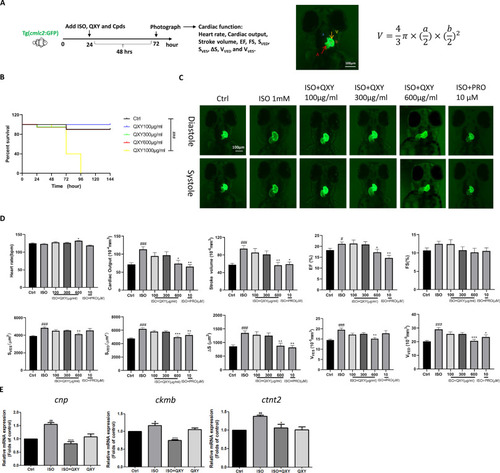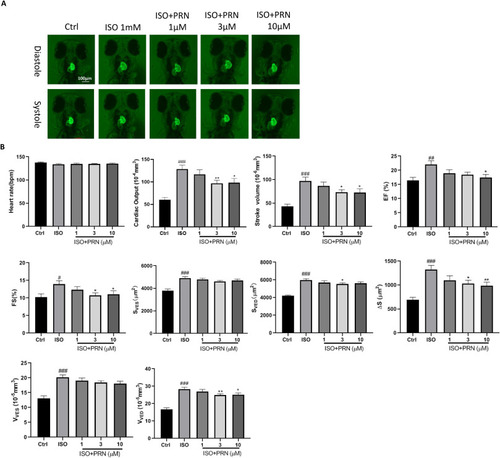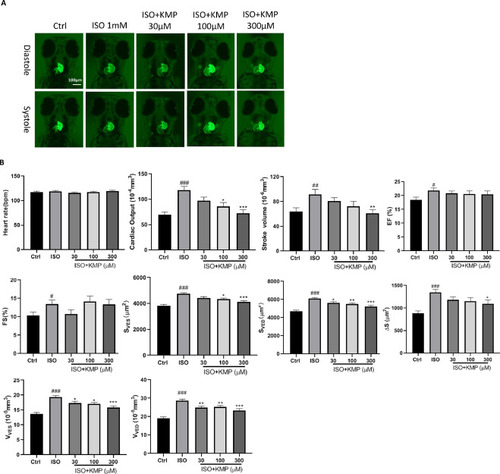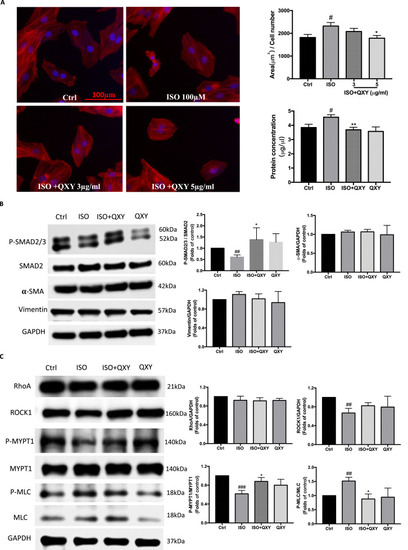- Title
-
Qiangxinyin formula protects against isoproterenol-induced cardiac hypertrophy
- Authors
- Zhou, Z.Y., Ma, J., Zhao, W.R., Shi, W.T., Zhang, J., Hu, Y.Y., Yue, M.Y., Zhou, W.L., Yan, H., Tang, J.Y., Wang, Y.
- Source
- Full text @ Phytomedicine
|
The protective effect of QXY on the ISO-induced cardiac hypertrophy, dysfunction and injury in zebrafish. (A) Experimental flow and the demonstration of cardiac imaging and calculation of ventricular volume in transgenic zebrafish Tg (cmlc2: GFP) embryos. (B) The survival curve of 24 h post-fertilization (hpf) zebrafish embryos treated with various concentrations (100, 300, 600 and 1000 µg/ml) of QXY extract for 5 days. (C) The pictures demonstrated the end-diastolic and systolic images of ventricle in various treatment groups. (D) Twenty-four hpf zebrafish embryos were treated with ISO (1 mM), with or without various concentrations (100, 200 and 600 µg/ml) of QXY extract, for 48 h, then the cardiac morphology was observed by an inverted fluorescence microscope as well as the calculation of heart rate, cardiac output, stroke volume, ejection fraction (EF), fractional shortening (FS), ventricular end-diastolic area (SVED), ventricular end-systolic area (SVES), SVED - SVES (∆S), ventricular end-diastolic volume (VVED) and ventricular end-systolic volume (VVES). Co-treatment of the beta-blocker propranolol (PRO, 10 µM) with ISO (1 mM) served as the positive control. (E) Twenty-four hpf zebrafish embryos were treated with ISO (1 mM), with or without QXY extract (600 µg/ml), for 48 h, then the mRNA expression levels of C-type natriuretic peptide (cnp), creatine kinase MB (ckmb) and cardiac troponin T 2 (ctnt2) were measured by real-time PCR, and the results were presented as folds of the control group. All the data were presented as mean ± SEM. #p < 0.05 and ###p < 0.001 vs control (Ctrl) group; *p < 0.05, **p < 0.01 and ***p < 0.001 vs ISO-treated group. |
|
The qualitative and quantitive analysis of the main contents of QXY extract by UHPLC-MS. (A-B) The total iron current in both positive and negative models and single iron monitor of mix standards including benzoylmesaconine, atractylenolide I, icariin, quercitrin, psoralen, kaempferol, ferulic acid and protocatechuic acid. (C-D) The total iron current in both positive and negative models and selected iron monitoring (SIM) of QXY extract. Red arrows indicated the standards or compounds in QXY extract. Retention times: Benzoylmesaconine, 5.93 min; Atractylenolide I, 11.46 min; Icariin, 6.56 min; Quercitrin, 5.36 min; Psoralen, 7.47 min; Kaempferol, 7.30 min; Ferulic acid, 5.26 min; Protocatechuic acid, 3.13 min. |
|
The chemical structures of QXY ingredients and their toxicity profiles in zebrafish. (A) The chemical structures of QXY ingredients. (B) The survival curve of 24 hpf zebrafish embryos treated with indicated concentrations of benzoylmesaconine (BMA), atractylenolide I (ATL I), icariin (ICA), quercitrin (QUE), psoralen (PRN), kaempferol (KMP), ferulic acid (FA) and protocatechuic acid (PCA) for 5 days. #p < 0.05, ##p < 0.01 and ###p < 0.001 vs control (Ctrl) group. |
|
The protective effect of psoralen (PRN) on ISO-induced cardiac hypertrophy and dysfunction in zebrafish. (A) The pictures demonstrated the end-diastolic and systolic image of ventricle in various treatment groups. (B) Twenty-four hpf zebrafish Tg(cmlc2: GFP) embryos were treated with ISO (1 mM), with or without various concentrations (1, 3 and 10 µM) of PRN, for 48 h, then the cardiac morphology was observed by an inverted fluorescence microscope as well as the calculation of heart rate, cardiac output, stroke volume, EF, FS, SVED, SVES, ∆S, VVED and VVES. All the data were presented as mean ± SEM. #p < 0.05 and ###p < 0.001 vs control (Ctrl) group; *p < 0.05, **p < 0.01 and ***p < 0.001 vs ISO-treated group. n = 4–6. |
|
The protective effect of kaempferol (KMP) on ISO-induced cardiac hypertrophy and dysfunction in zebrafish. (A) The pictures demonstrated the end-diastolic and systolic image of ventricle in various treatment groups. (B) Twenty-four hpf zebrafish Tg(cmlc2: GFP) embryos were treated with ISO (1 mM), with or without various concentrations (30, 100 and 300 µM) of KMP, for 48 h, then the cardiac morphology was observed by an inverted fluorescence microscope as well as the calculation of heart rate, cardiac output, stroke volume, EF, FS, SVED, SVES, ∆S, VVED and VVES. All the data were presented as mean ± SEM. #p < 0.05, ##p < 0.01 and ###p < 0.001 vs control (Ctrl) group; *p < 0.05, **p < 0.01 and ***p < 0.001 vs ISO-treated group. n = 4–6. |
|
The protective effect of icaritin (ICT) on ISO-induced cardiac hypertrophy and dysfunction in zebrafish. (A) The demonstration of ICA catalyzed to ICT by hydrolysis of the glucose groups. (B) The survival curve of 24 hpf zebrafish WT embryos treated with various concentrations (10, 30, 100, 300 and 1000 µM) of ICT for 5 days. (C) The pictures demonstrated the end-diastolic and systolic image of ventricle in various treatment groups. (D) Twenty-four hpf zebrafish Tg(cmlc2: GFP) embryos were treated with ISO (1 mM), with or without various concentrations (10, 30 and 100 µM) of ICT, for 48 h, then the cardiac morphology were observed by an inverted fluorescence microscope as well as the calculation of heart rate, cardiac output, stroke volume, EF, FS, SVED, SVES, ∆S, VVED and VVES. All the data were presented as mean ± SEM. #p < 0.05, ##p < 0.01 and ###p < 0.001 vs control (Ctrl) group; *p < 0.05 and **p < 0.01 vs ISO-treated group. n = 4–6. |
|
The protective effect of QXY on ISO-induced calcium influx and mitochondrial dysfunction in H9c2 cells. (A) The transcriptome profile of the regulation of gene expression and its GO enrichment of differentially expressed genes (DEGs) between QXY-treated and control groups. Red rectangle presented that DEGs were enriched with the item of calcium binding. (B) The intracellular calcium imaging of H9c2 cells, which were pre-treated with QXY (20 µg/ml) or nifedipine (NIF, 2 µM) for 15 min, challenged with ISO (1 µM). The L-type calcium channel blocker NIF served as the positive control. The intracellular Ca2+ change was presented as the real-time fluorescence intensity (F1) to the fluorescence intensity before stimulation (F0), which indicated by the color change in the real-time imaging. (C-D) The H9c2 cells were treated with ISO (100 µM), with or without QXY (3 µg/ml, 5 µg/ml), for 24 h. The mitochondrial membrane potential were detected by JC-1 staining and calculated by the fluorescence intensity ratio of Green (monomeric JC-1) / Red (aggregated JC-1). (E-F) The H9c2 cells were treated with ISO (100 µM), with or without QXY (5 µg/ml), for 24 h. Then the cells were harvested and followed by intracellular MDA and ATP assays according to the manufactures. All the data were presented as mean ± SEM. #p < 0.05, ##p < 0.01 and ###p < 0.001 vs control (Ctrl) group; *p < 0.05 and **p < 0.01 vs ISO-treated group. n = 4–6. |
|
The protective effect and mechanism of QXY on ISO-induced cytoskeleton reorganization and hypertrophy in H9c2 cells. (A) The H9c2 cells were treated with ISO (100 µM), with or without QXY (3 µg/ml, 5 µg/ml), for 24 h. The intracellular cytoskeleton and nuclei were stained with Actin-Tracker Red-Rhodamine and DAPI, respectively. The protein concentration of cells was measured by BCA analysis. (B-C) The H9c2 cells were treated with ISO (100 µM), with or without QXY (5 µg/ml), for 24 h. The protein expression levels of phosphor-SMAD2/3, SMAD2, α-SMA, Vimentin, RhoA, ROCK1, phosphor-MYPT1, MYPT1, phosphor-MLC, and MLC were detected by western blotting. GAPDH served as the internal control. All the data were presented as mean ± SEM. #p < 0.05, ##p < 0.01 and ###p < 0.001 vs control (Ctrl) group; *p < 0.05 and **p < 0.01 vs ISO-treated group. n = 4–6. |
|
Schematic overview of the underlying mechanisms of QXY protecting against ISO-induced cardiac hypertrophy and heart failure. |
Reprinted from Phytomedicine : international journal of phytotherapy and phytopharmacology, 130, Zhou, Z.Y., Ma, J., Zhao, W.R., Shi, W.T., Zhang, J., Hu, Y.Y., Yue, M.Y., Zhou, W.L., Yan, H., Tang, J.Y., Wang, Y., Qiangxinyin formula protects against isoproterenol-induced cardiac hypertrophy, 155717155717, Copyright (2024) with permission from Elsevier. Full text @ Phytomedicine









